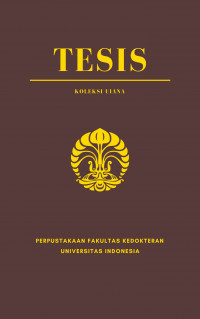Tesis
Efektivitas Airway Pressure Release Ventilation (APRV) dibandingkan Ventilasi Mekanis Konvensional dalam Manajemen Gagal Napas Pasien Tersangka Covid-19: Laporan Kasus Berbasis Bukti = The Effectiveness of Airway Pressure Release Ventilation (APRV) Compared to Coventional Mechanical Ventilation in Manegement of Respiratory Failure in Covid-19 Patients: an Evidence Based Case Report.
Latar Belakang. Bulan Maret 2020, World Health Organization mengumumkan Covid-19 sebagai sebuah pandemi global. Hingga saat ini, kasus Covid-19 masih terus bertambah dengan angka kematian mencapai lebih dari 590.000 kasus di seluruh dunia. Covid-19 terutama mempengaruhi sistem pernapasan menyebabkan pneumonia dan dapat secara cepat bertambah berat dan masuk ke dalam kondisi acute respiratory distress syndrome (ARDS). Tingginya kebutuhan bantuan ventilasi mekanis pada pasien Covid-19 dengan ARDS membuat para petugas medis harus terus mencari tatalaksana yang paling tepat, termasuk moda ventilasi mekanis yang cocok digunakan pada pasien Covid-19. Moda airway pressure release ventilation (APRV) terus berkembang dan pengunaannya terus bertambah, terutama dalam tatalaksana gagal napas dan ARDS. Pada laporan kasus berbasis bukti ini, kami membahas efektivitas APRV dibandingkan ventilasi mekanis konvensional dalam manajemen gagal napas pasien tersangka Covid-19 dengan komplikasi ARDS. Metode. Metode laporan kasus berbasis bukti ini mengikuti pedoman Preferred Reporting Items for Systematic Reviews and Meta-analyses (PRISMA). Pencarian sistematis dilakukan menggunakan database elektronik yaitu Pubmed®, Ebsco®, Cochrane Library® dan Science Direct® dengan menggunakan kata kunci airway pressure release ventilation, acute respiratory distress syndrome, dan Covid. Hasil. Tiga artikel dengan desain studi randomized control trials (RCT) dan satu artikel studi observasional retrospektif didapatkan dari hasil pencarian. Keempat artikel menunjukkan adanya peningkatan rasio PaO2/FiO2 setelah intervensi dan dua artikel menyimpulkan bahwa APRV diasosiasikan dengan berkurangnya lama rawat di ICU. Simpulan. Pada kasus pasien Covid-19 dengan komplikasi ARDS (tipe H), APRV dapat menjadi alternatif moda ventilator yang dapat digunakan sebagai tatalaksana bantuan ventilasi mekanis meskipun APRV tidak dapat dikatakan lebih efektif dibandingkan moda ventilator konvensional.
Kata Kunci. airway pressure release ventilation, acute respiratory distress syndrome, Covid.
Background. In March 2020, World Health Organization (WHO) stated that Covid-19 was a global pandemic. Currently, the number of case is still inclining with mortality rate more than 590,000 cases worldwide. This disease mainly affects the respiratory system that will lead to pneumonia, and quickly becoming worse so that will fall into acute respiratory distress syndrome (ARDS) condition. The high demand of mechanical ventilation in patients with Covid-19 and ARDS encourages medical workers to find the appropriate managements, including this mechanical ventilation mode. The airway pressure release ventilation (APRV) mode continuously develops and its utilization consistently increases, especially in the management of respiratory failure and ARDS. This evidence based case report elaborates the effectiveness of APRV compared to conventional mechanical ventilation in the management of respiratory failure in patients suspicious of Covid-19 with ARDS complications. Methods. The method of this evidence based case report was performed based on Preferred Reporting Items for Systematic Reviews and Meta-analyses (PRISMA). Systematic exploration was conducted through electronic database, such as Pubmed, EBSCO, Cochrane Library, and Science Direct, with airway pressure release ventilation, acute respiratory distress syndrome, and Covid as the keywords. Results. There were 3 randomized control trials (RCT) and 1 observational study revealed to be relevant to this study. There 4 articles mentioned the increasing of PaO2/FiO2 ratio following intervention. Two of those studies also stated that APRV was associated with the shorter length of hospitalization in Intensive Care Unit (ICU). Conclusion. In patients with Covid-19 and ARDS complication (type H), APRV can be an alternative ventilator mode to assist mechanical ventilation, although APRV cannot be said more effective than conventional ventilator mode.
Keywords. airway pressure release ventilation, acute respiratory dystress syndrome, Covid
- Judul Seri
-
-
- Tahun Terbit
-
2020
- Pengarang
-
Claudia lunaesti - Nama Orang
Andi Ade Wijaya - Nama Orang
Christoper Kapuangan - Nama Orang
Adhrie Sugiarto - Nama Orang - No. Panggil
-
T20194fk
- Penerbit
- Jakarta : Program Studi Anestesiologi dan Terapi Intensif., 2020
- Deskripsi Fisik
-
xii, 26 hal; ill; 21 x 30 cm
- Bahasa
-
Indonesia
- ISBN/ISSN
-
-
- Klasifikasi
-
NONE
- Edisi
-
-
- Subjek
- Info Detail Spesifik
-
-
| T20194fk | T20194fk | Perpustakaan FKUI | Tersedia |


Masuk ke area anggota untuk memberikan review tentang koleksi